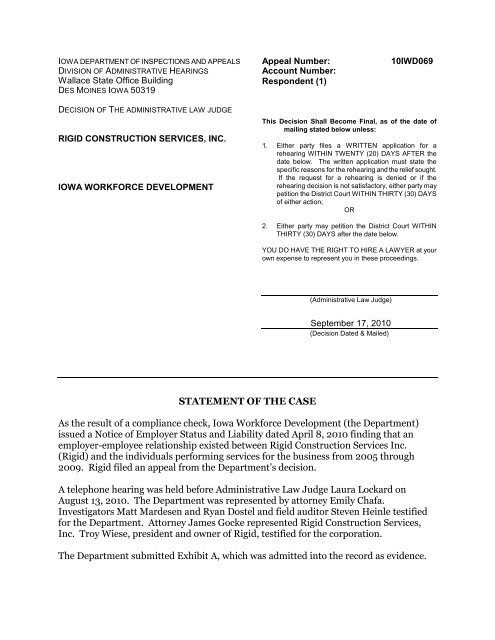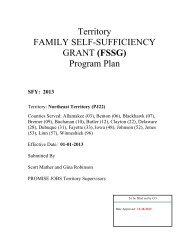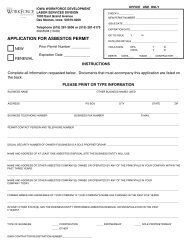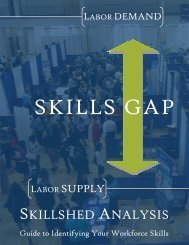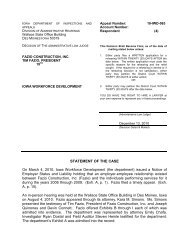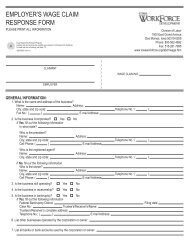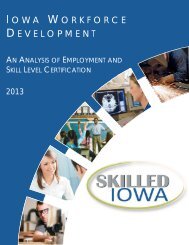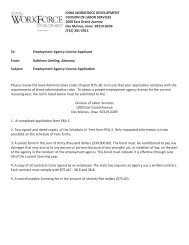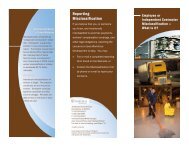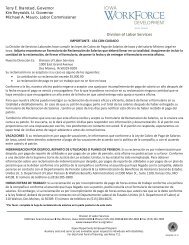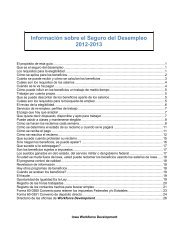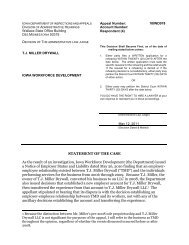RIGID CONSTRUCTION SERVICES, INC. vs IWD 10-IWD-069 (ALJ ...
RIGID CONSTRUCTION SERVICES, INC. vs IWD 10-IWD-069 (ALJ ...
RIGID CONSTRUCTION SERVICES, INC. vs IWD 10-IWD-069 (ALJ ...
Create successful ePaper yourself
Turn your PDF publications into a flip-book with our unique Google optimized e-Paper software.
IOWA DEPARTMENT OF INSPECTIONS AND APPEALSDIVISION OF ADMINISTRATIVE HEARINGSWallace State Office BuildingDES MOINES IOWA 50319Appeal Number:Account Number:Respondent (1)<strong>10</strong><strong>IWD</strong><strong>069</strong>DECISION OF THE ADMINISTRATIVE LAW JUDGE<strong>RIGID</strong> <strong>CONSTRUCTION</strong> <strong>SERVICES</strong>, <strong>INC</strong>.IOWA WORKFORCE DEVELOPMENTThis Decision Shall Become Final, as of the date ofmailing stated below unless:1. Either party files a WRITTEN application for arehearing WITHIN TWENTY (20) DAYS AFTER thedate below. The written application must state thespecific reasons for the rehearing and the relief sought.If the request for a rehearing is denied or if therehearing decision is not satisfactory, either party maypetition the District Court WITHIN THIRTY (30) DAYSof either action;OR2. Either party may petition the District Court WITHINTHIRTY (30) DAYS after the date below.YOU DO HAVE THE RIGHT TO HIRE A LAWYER at yourown expense to represent you in these proceedings.(Administrative Law Judge)September 17, 20<strong>10</strong>(Decision Dated & Mailed)STATEMENT OF THE CASEAs the result of a compliance check, Iowa Workforce Development (the Department)issued a Notice of Employer Status and Liability dated April 8, 20<strong>10</strong> finding that anemployer-employee relationship existed between Rigid Construction Services Inc.(Rigid) and the individuals performing services for the business from 2005 through2009. Rigid filed an appeal from the Department’s decision.A telephone hearing was held before Administrative Law Judge Laura Lockard onAugust 13, 20<strong>10</strong>. The Department was represented by attorney Emily Chafa.Investigators Matt Mardesen and Ryan Dostel and field auditor Steven Heinle testifiedfor the Department. Attorney James Gocke represented Rigid Construction Services,Inc. Troy Wiese, president and owner of Rigid, testified for the corporation.The Department submitted Exhibit A, which was admitted into the record as evidence.
Docket No. <strong>10</strong><strong>IWD</strong><strong>069</strong>Page 2ISSUEWhether the Department correctly determined that an employer-employee relationshipexisted between Rigid Construction Services Inc. and individuals performing services forthe business from 2005 to 2009.FINDINGS OF FACTOn October 9, 2009, investigators Matt Mardesen and Ryan Dostal with themisclassification unit of the Department’s tax bureau conducted a compliance check at aresidential new construction site in Grimes, Iowa. Upon arrival, the investigatorsobserved the job site for several minutes before initiating contact with the individualsworking on the home. The investigators noted a large trailer with “Rigid Construction”on the side. As they approached the site, they observed three men working. The homewas in the process of being framed. Two of the workers, later identified as ChadGaletich and Ryan Pierce, advised the investigators that Troy Wiese was in charge at thesite. (Exh. A, p. <strong>10</strong>; Mardesen testimony). Mr. Mardesen primarily interviewed Mr.Wiese, while Mr. Dostal primarily interviewed Mr. Galetich and Mr. Pierce. (Mardesen,Dostal testimony).During the on-site interview, Mr. Wiese told the Department representatives that he wasa registered contractor and that the workers at the job site were subcontractors ratherthan employees and were issued <strong>10</strong>99s at the end of each year. Mr. Wiese did not knowwhether the workers on the site with him were registered as contractors with the state ofIowa. Mr. Wiese stated that the majority of tools on the site belonged to him and wereused by the workers on-site. Mr. Wiese also informed the investigators that he hadanother framing crew working at a different site on the same date. (Mardesentestimony).Mr. Galetich and Mr. Pierce reported to Mr. Dostal that the tools and equipment theyused were largely provided by Mr. Wiese. Each did have a tool belt with their own handtools. They both indicated that they only worked for Mr. Wiese at the time of thecompliance check, though each one had worked for other contractors in the past.(Dostal testimony).Mr. Mardesen did not observe Mr. Wiese giving the workers any verbal instructionswhile he was on the site. When the investigators initially arrived, Mr. Pierce wasuncooperative and would not give his name. When Mr. Wiese joined the conversation,Mr. Wiese told Mr. Pierce that he should just give his name to the investigators.(Mardesen testimony).During the compliance check, Mr. Wiese, Mr. Pierce, and Mr. Galetich were each giventhe Department’s questionnaire to determine the status of workers and were asked tocomplete the questionnaire and return it to the Department. None of the three everreturned the questionnaire. (Mardesen testimony).After the compliance check, the Department verified that Rigid was registered with theState of Iowa. The Secretary of State’s web site listed Kevin Davidson as president and
Docket No. <strong>10</strong><strong>IWD</strong><strong>069</strong>Page 3treasurer of Rigid. Troy Wiese was listed as secretary. (Exh. A, p. 124). Rigid had anactive unemployment insurance account with the Department. The only two individualswho Rigid reported were paid wages from 2005 onward were Troy Wiese and KevinDavidson. (Exh. A, p. <strong>10</strong>). By 2009, when the Department conducted its compliancecheck, Mr. Davidson was no longer involved with Rigid. (Wiese testimony). Thecorporation, however, had not registered any changes in its corporate officers with theSecretary of State’s office. (Mardesen testimony).On October 30, 2009, Mr. Mardesen followed up with Mr. Wiese in an attempt to get thequestionnaire that Mr. Wiese was provided on-site completed and returned. Mr. Wiesereported that he had turned the questionnaire over to his accountant, who had not yetfilled it out. Mr. Wiese had questions about the factors that went into a determination ofwhether a worker was an employee or independent contractor. Mr. Mardesen agreed toe-mail Mr. Wiese a link to the Department’s regulations on this point as well as anothercopy of the questionnaire. Mr. Mardesen did so in early November, 2009. In his e-mail,he requested that Mr. Wiese complete the questionnaire and return it as soon aspossible. Mr. Wiese never did so. (Exh. A, p. 11, 126; Mardesen testimony).About a week after the e-mail request, Mr. Mardesen sent Mr. Wiese a Notice to ProduceRecords. The notice scheduled a meeting on November 23, 2009 at 8:30 AM to discusspotential delinquent unemployment insurance compensation fund contributions from2005 to present. In connection with the meeting, the notice requested that Rigidproduce payroll records from 2005 to present, a disbursement journal and ledgers for2005 to present, personal and business tax returns from 2005 to present, copies of all<strong>10</strong>99s issued, all <strong>10</strong>96 forms, all W-2 and W-3 forms issued, and the “941 Federal Form”from 2005 to present. (Exh. A, p. 127). Rigid ultimately submitted copies of the <strong>10</strong>96,<strong>10</strong>99, and W-2 forms that it had issued from 2005 through 2009. Rigid did not submitany tax returns or payroll records. (Mardesen testimony).After completing its investigation, the Department determined that the workers who didframing work for Rigid were employees rather than independent contractors. Based onits investigation, the Department concluded that Rigid had the right to direct andcontrol the workers at its job sites. The Department also considered the continuingrelationship between some of the workers who received <strong>10</strong>99s from Rigid and thecorporation during the time period of its operation. One of the workers had worked forRigid for the previous four years. Four or more workers had two or more consecutiveyears of service. Another factor the Department considered was that Rigid provided thetools the workers used. The Department determined that Rigid had the maininvestment in and control of the project. The Department did not believe that theworkers had independent profit or loss potential. Based on the fact that neither of thetwo workers at the job site where the compliance check was completed was registered asa contractor in Iowa, the Department determined that neither of these individuals werein business for themselves or offered their services to other framing contractors.11 When examining the financial documents that Rigid provided, Mr. Mardesen discovered that<strong>10</strong>99s were issued to two workers, John Kleen and Terry Rushing, under a federal employeridentification number. Mr. Mardesen discovered that Mr. Kleen is a registered contractor inIowa. Because of these factors, the monies paid to Mr. Kleen and Mr. Rushing were not includedin the quarterly wage reports the Department prepared for Rigid. The Department determined
Docket No. <strong>10</strong><strong>IWD</strong><strong>069</strong>Page 4The Department issued a Notice of Employer Status and Liability on April 8, 20<strong>10</strong>. Thatdecision determined that an employer-employee relationship existed between Rigid andthe individuals performing services for the business from 2005 through 2009. Thenotice indicated that compensation for the years 2005 through 2009 was being reportedfor unemployment purposes. (Exh. A, p. 9). Rigid appealed the Department’s decision.(Exh. A, p. 136).At hearing, Mr. Wiese acknowledged that he did provide some tools for the workers whoworked on Rigid’s jobs. He provides a forklift, an air compressor, and other specialtytools that the average person does not have, such as a sawzall, a nail gun, and an oil gun.(Wiese testimony).Mr. Wiese explained at hearing that his typical day at a job site just involves “com[ing]to work.” He explained that he would determine whether reasonable progress had beenmade on the job and observe whether framing was done according to plan. If thingswere not being done according to plan, he would instruct the framing crew to makecorrections. (Wiese testimony).REASONING AND CONCLUSIONS OF LAWFor purposes of unemployment compensation, an “employer” is defined as anemploying unit that, in any calendar quarter in the current or preceding calendar year,paid wages of $1,500 or more, or employed at least one individual for some portion of aday in each of twenty different calendar weeks during the current or preceding calendaryear.2 “Employment” is defined as service performed for wages or under any contract ofhire, written or oral, express or implied.3 When an employer claims that anyemployment is not employment under the Iowa Employment Security Law, the burdenis on the employer to prove the exemption claimed.4In the unemployment compensation context, it is well-settled that “the right to controlthe manner and means of performance is the principal test in determining whether aworker is an employee or independent contractor.”5The relationship of employer and employee exists when the person forwhom services are performed has the right to control and direct theindividual who performs the services, not only as to the result to beaccomplished by the work but also as to the details and means by whichthat result is accomplished. An employee is subject to the will and controlof the employer not only as to what shall be done but how it shall be done.It is not necessary that the employer actually direct or control the mannerin which the services are performed; it is sufficient if the employer has thethat Rigid did not owe unemployment contributions on these sums. (Exh. A, p. 11).2 Iowa Code § 96.19(16)(a) (2009).3 Iowa Code § 96.19(18)(a) (2009).4 871 Iowa Administrative Code (IAC) 22.7(3), 23.55(2).5 Gaffney v. Department of Employment Services, 540 N.W.2d 430, 434 (Iowa 1995).
Docket No. <strong>10</strong><strong>IWD</strong><strong>069</strong>Page 5right to do so. 6The Department’s regulations set out in some detail the factors to be considered indetermining whether a worker is an employee or an independent contractor.7 Factorsthat support the existence of an employer-employee relationship include: Right to discharge an employee without being held liable for damages for breach ofcontract; Furnishing of tools, equipment, material, and a place to work; Continuous performance of work for the employer; Payment of a fixed wage on a weekly or hourly basis.Factors that support an independent contractor relationship include: Performance of a specific job at a fixed price; Following a distinct trade, occupation, business, or profession in which anindividual offers services to the public to be performed without the control ofthose seeking the benefit of his or her training or experience; Unreimbursed expenses and fixed, ongoing costs regardless of whether work iscurrently being performed; Significant investment in real or personal property that is used in performingservices for someone else; Right to employ assistants with the exclusive right to supervise their activity andcompletely delegate the work.8The regulations also provide that if, upon examination of the facts of a case, anemployer-employee relationship exists, the designation or description by the parties oftheir relationship as anything other than an employer and employee is immaterial.9Rigid argued at hearing that the Department made its finding that Rigid’s workers wereemployees based on minimal investigation and observation. While it is true that detailsof the workers’ relationship with Rigid are skimpy here, it is no less true that Rigid hadevery opportunity to provide the Department with additional information to aid in thedetermination. The Department provided Mr. Wiese with a questionnaire to aid indetermining the status of workers at least two times and he declined to return it. TheDepartment made a formal request of Rigid to view its payroll records, tax returns, andother financial documents, which Rigid declined to produce. Finally, Rigid had anopportunity at hearing to present additional information in support of its assertion thatits workers were properly classified as independent contractors. The employer has theburden in these cases to prove that a work relationship is exempt from the IowaEmployment Security Law. Having failed to fully cooperate with the Department andhaving failed to shed much additional light at hearing on how the workers interactedwith Rigid, Rigid is not in a favorable position to complain about the lack of information6 871 IAC 23.19(1).7 See generally 871 IAC 23.19.8 871 IAC 23.19.9 871 IAC 23.19(7).
Docket No. <strong>10</strong><strong>IWD</strong><strong>069</strong>Page 6that the Department used in making its decision.The evidence that was presented regarding Rigid’s relationship with its workerssupports the Department’s conclusion that the workers were employees. Rigid wasproviding the workers with tools and equipment and both of the employees who wereinterviewed were only working for Rigid at the time. The Department’s investigationrevealed that a number of workers had worked for Rigid over a period of years. Neitherof the two employees interviewed was registered as a contractor in Iowa, which supportsthe Department’s conclusion that neither was offering his services to the general public.Rigid presented no evidence to show whether the workers were paid an hourly rate or afixed price for a job. Rigid provided no evidence to contradict the Department’stestimony that the workers who were interviewed were only working for Rigid and notfor any other employers. There was no evidence provided by Rigid regarding workershaving any fixed costs with respect to the job, nor any evidence to show that the workerswere unable to leave without incurring financial costs over and above a loss of wages.In order to prevail on its assertion that its workers are independent contractors, Rigidbears the burden of proving that it does not have the right to direct and control the workits workers are performing. It failed to meet this burden.DECISIONThe Department’s decision dated April 8, 20<strong>10</strong> is AFFIRMED. The Department shalltake any action necessary to implement this decision.


